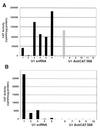Reduction of target gene expression by a modified U1 snRNA
- PMID: 11283260
- PMCID: PMC86911
- DOI: 10.1128/MCB.21.8.2815-2825.2001
Reduction of target gene expression by a modified U1 snRNA
Abstract
Although the primary function of U1 snRNA is to define the 5' donor site of an intron, it can also block the accumulation of a specific RNA transcript when it binds to a donor sequence within its terminal exon. This work was initiated to investigate if this property of U1 snRNA could be exploited as an effective method for inactivating any target gene. The initial 10-bp segment of U1 snRNA, which is complementary to the 5' donor sequence, was modified to recognize various target mRNAs (chloramphenicol acetyltransferase [CAT], beta-galactosidase, or green fluorescent protein [GFP]). Transient cotransfection of reporter genes and appropriate U1 antitarget vectors resulted in >90% reduction of transgene expression. Numerous sites within the CAT transcript were suitable for targeting. The inhibitory effect of the U1 antitarget vector is directly related to the hybrid formed between the U1 vector and target transcripts and is dependent on an intact 70,000-molecular-weight binding domain within the U1 gene. The effect is long lasting when the target (CAT or GFP) and U1 antitarget construct are inserted into fibroblasts by stable transfection. Clonal cell lines derived from stable transfection with a pOB4GFP target construct and subsequently stably transfected with the U1 anti-GFP construct were selected. The degree to which GFP fluorescence was inhibited by U1 anti-GFP in the various clonal cell lines was assessed by fluorescence-activated cell sorter analysis. RNA analysis demonstrated reduction of the GFP mRNA in the nuclear and cytoplasmic compartment and proper 3' cleavage of the GFP residual transcript. An RNase protection strategy demonstrated that the transfected U1 antitarget RNA level varied between 1 to 8% of the endogenous U1 snRNA level. U1 antitarget vectors were demonstrated to have potential as effective inhibitors of gene expression in intact cells.
Figures








References
-
- Ashe M P, Griffin P, James W, Proudfoot N J. Poly(A) site selection in the HIV-1 provirus: inhibition of promoter-proximal polyadenylation by the downstream major splice donor site. Genes Dev. 1995;9:3008–3025. - PubMed
-
- Baker C C. An improved chloramphenicol acetyltransferase expression vector system for mapping transcriptional and post-transcriptional regulatory elements in animal cells. In: Alitalo K K, et al., editors. Recombinant systems in protein expression. Amsterdam, The Netherlands: Elsevier Science Publishers B. V.; 1990. pp. 75–86.
Publication types
MeSH terms
Substances
Grants and funding
LinkOut - more resources
Full Text Sources
Other Literature Sources
Miscellaneous
